Low-thrust jet propulsion systems
Low-thrust jetpropulsion systems
LIQUID-PROPELLANT LOW-THRUST THRUSTERS
LIQUID-PROPELLANT
LOW-THRUST THRUSTERS
THRUST 30 N AND 100 N
DESCRIPTION
BASIC SPECIFICATIONS
| Parameter | Cyclone-4 thruster | Cyclone-3 thruster | Cyclone-3 thruster | Okean-O thruster |
| Propellants: | ||||
| – oxidizer | Nitrogen Tetroxide | |||
| – fuel | Unsymmetrical Dimethylhydrazine | |||
| Nominal thrust, N | 30 | 100 | 30 | 30 |
| Specific impulse in continuous running at nominal propellant inlet pressure, m/s | 2000 | 2600 | 2600 | 2600 |
| Chamber pressure, MPa | 0.1 | 0.7 | 0.7 | 0.7 |
| Nominal propellant inlet pressure, MPa | Oxidizer 0.53 Fuel 0.25 | 1.35 | 1.35 | 1.35 |
| Nominal mixture ratio | 1.85 | 1.6 | 1.3 | 1.6 |
| Guaranteed number of ignitions | 30000 | 1300 | 1300 | 50000 |
| Total running time, s | 5600 | 200 | 200 | 3600 |
| Duration of a single ignition, s | 0.21 / 2000 | 0.21 / 165 | 0.21 / 165 | 0.21 / 600 |
| Supply voltage, V | 28 | 28 | 28 | 28 |
| Mass, kg | 1.16 | 1.45 | 1.3 | 1.3 |
TESTS
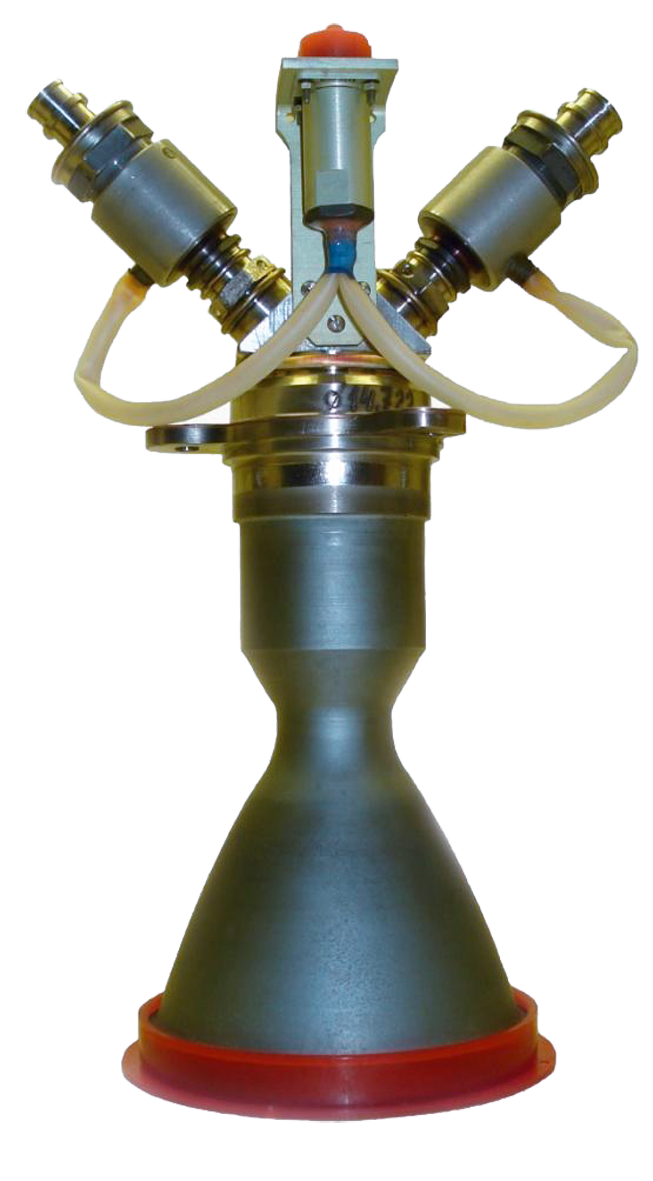
CYCLONE-4 ROCKET 30-NEWTON THRUSTER
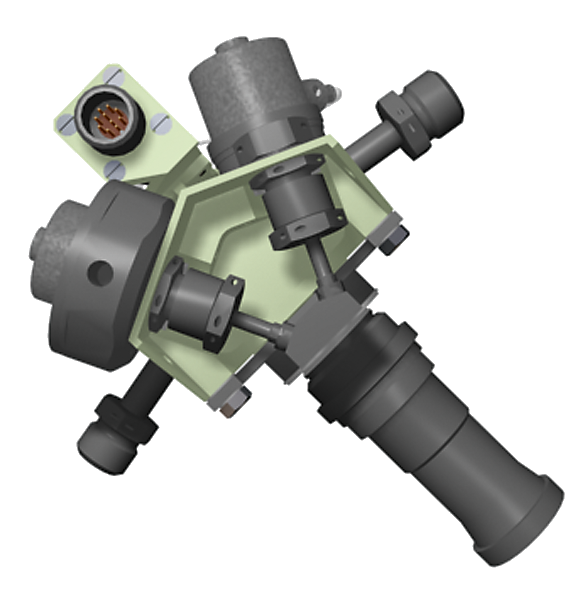
CYCLONE-3 ROCKET 100-NEWTON THRUSTER
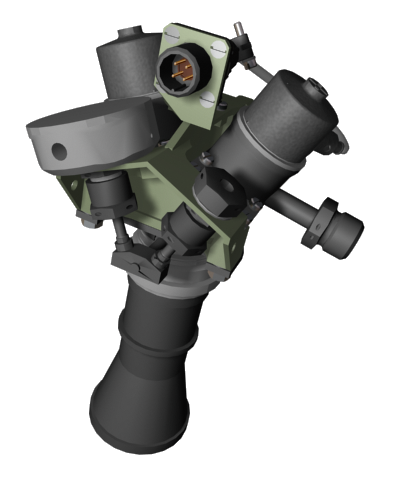
CYCLONE-3 ROCKET 30-NEWTON THRUSTER
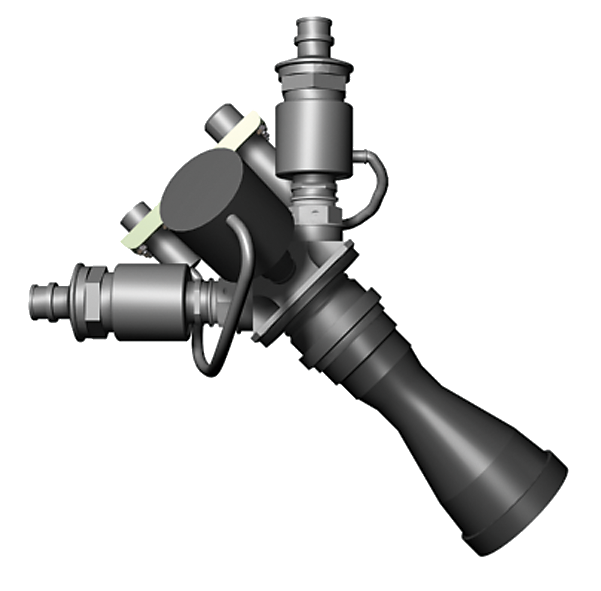
OKEAN-O SPACECRAFT 30-NEWTON THRUSTER
Low-thrust jet propulsion systems
LIQUID-PROPELLANT LOW-THRUST THRUSTERS
LIQUID-PROPELLANT
LOW-THRUST THRUSTERS
THRUST 30 N AND 100 N
CYCLONE-4 ROCKET 30-NEWTON THRUSTER
DESCRIPTION
TESTS

CYCLONE-4 ROCKET 30-NEWTON THRUSTER
BASIC SPECIFICATIONS
| Parameter | Cyclone-4 thruster |
| Propellants: | |
| – oxidizer | Nitrogen Tetroxide |
| – fuel | Unsymmetrical Dimethylhydrazine |
| Nominal thrust, N | 30 |
| Specific impulse in continuous running at nominal propellant inlet pressure, m/s | 2000 |
| Chamber pressure, MPa | 0.1 |
| Nominal propellant inlet pressure, MPa | Oxidizer 0.53 Fuel 0.25 |
| Nominal mixture ratio | 1.85 |
| Guaranteed number of ignitions | 30000 |
| Total running time, s | 5600 |
| Duration of a single ignition, s | 0.21 / 2000 |
| Supply voltage, V | 28 |
| Mass, kg | 1.16 |

CYCLONE-3 ROCKET 100-NEWTON THRUSTER
BASIC SPECIFICATIONS
| Parameter | Cyclone-3 thruster |
| Propellants: | |
| oxidizer | Nitrogen Tetroxide |
| fuel | Unsymmetrical Dimethylhydrazine |
| Nominal thrust, N | 30 |
| Specific impulse in continuous running at nominal propellant inlet pressure, m/s | 2600 |
| Chamber pressure, MPa | 0.7 |
| Nominal propellant inlet pressure, MPa | 1.35 |
| Nominal mixture ratio | 1.3 |
| Guaranteed number of ignitions | 1300 |
| Total running time, s | 200 |
| Duration of a single ignition, s | 0.21 / 165 |
| Supply voltage, V | 28 |
| Mass, kg | 1.3 |

CYCLONE-3 ROCKET 30-NEWTON THRUSTER
BASIC SPECIFICATIONS
| Parameter | Cyclone-3 thruster |
| Propellants: | |
| oxidizer | Nitrogen Tetroxide |
| fuel | Unsymmetrical Dimethylhydrazine |
| Nominal thrust, N | 30 |
| Specific impulse in continuous running at nominal propellant inlet pressure, m/s | 2600 |
| Chamber pressure, MPa | 0.7 |
| Nominal propellant inlet pressure, MPa | 1.35 |
| Nominal mixture ratio | 1.3 |
| Guaranteed number of ignitions | 1300 |
| Total running time, s | 200 |
| Duration of a single ignition, s | 0.21 / 165 |
| Supply voltage, V | 28 |
| Mass, kg | 1.3 |
CYCLONE-3 ROCKET 30-NEWTON THRUSTER

OKEAN-O SPACECRAFT 30-NEWTON THRUSTER
BASIC SPECIFICATIONS
| Parameter | Okean-O thruster |
| Propellants: | |
| oxidizer | Nitrogen Tetroxide |
| fuel | Unsymmetrical Dimethylhydrazine |
| Nominal thrust, N | 30 |
| Specific impulse in continuous running at nominal propellant inlet pressure, m/s | 2600 |
| Chamber pressure, MPa | 0.7 |
| Nominal propellant inlet pressure, MPa | 1.35 |
| Nominal mixture ratio | 1.6 |
| Guaranteed number of ignitions | 50000 |
| Total running time, s | 3600 |
| Duration of a single ignition, s | 0.21 / 600 |
| Supply voltage, V | 28 |
| Mass, kg | 1.3 |
GAS-JET PROPULSION SYSTEMS
GJPS
GAS-JET PROPULSION SYSTEMS
DESCRIPTION
BASIC SPECIFICATIONS
| Working medium – air, nitrogen, argon | |
| Maximum bottle pressure at 20°С, MPa | 23 |
| Nominal gas pressure upstream engines, MPa | 0.3 |
| Total thrust impulse, N·s | 250 – 7000 |
| Nominal engine thrust, N | 0.1; 0.2; 8.5 – 55 |
| Thrust excursion in all operating environments, % | ±25 |
| Specific impulse in 20°C air, m/s | 710 |
TESTS
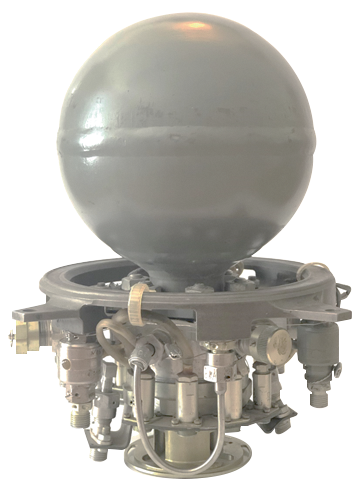
GAS-JET PROPULSION SYSTEMS
GJPS
GAS-JET PROPULSION SYSTEMS

DESCRIPTION
BASIC SPECIFICATIONS
| Working medium – air, nitrogen, argon | |
| Maximum bottle pressure at 20°С, MPa | 23 |
| Nominal gas pressure upstream engines, MPa | 0.3 |
| Total thrust impulse, N·s | 250 – 7000 |
| Nominal engine thrust, N | 0.1; 0.2; 8.5 – 55 |
| Thrust excursion in all operating environments, % | ±25 |
| Specific impulse in 20°C air, m/s | 710 |
TESTS
SPACECRAFT PROPULSION SYSTEMS
SPACECRAFT PROPULSION SYSTEMS
HALL-ENGINE-BASED ELECTRIC JET PROPULSION SYSTEM
HALL-ENGINE-BASED ELECTRIC
JET PROPULSION SYSTEM
SPACECRAFT PROPULSION SYSTEMS
DESCRIPTION
BASIC SPECIFICATIONS
| Working medium – xenon | |
| Maximum bottle pressure at 50°С, MPa | 13 |
| Total thrust impulse, kN·s | 50 – 1000 |
| Nominal Hall engine thrust, mN | 1 – 66 |
| Thrust excursion in all operating environments, % | 15 |
| Specific impulse of Hall engines in continuous running mode in nominal environment, m/s | 2200 -22000 |
| Engine thrust-to-power ratio, W/mN | 16-20 |
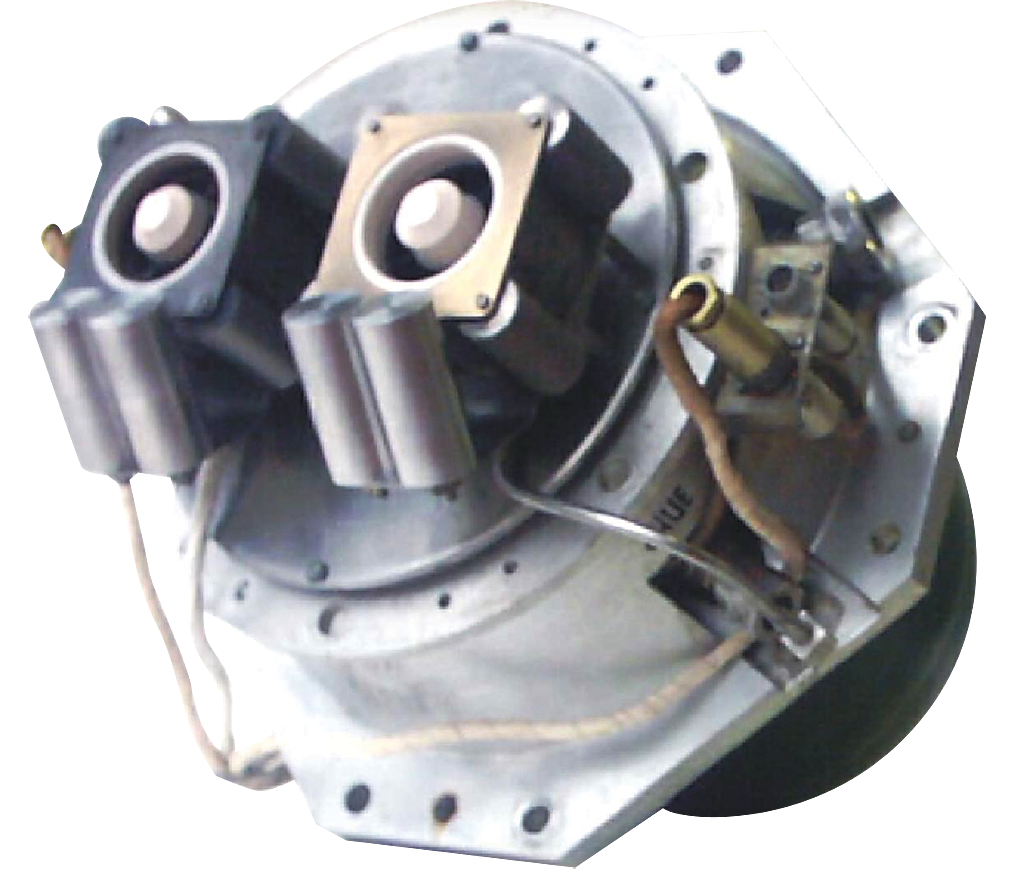
HALL-ENGINE-BASED ELECTRIC JET PROPULSION SYSTEM
HALL-ENGINE-BASED ELECTRIC
JET PROPULSION SYSTEM
SPACECRAFT PROPULSION SYSTEMS

DESCRIPTION
BASIC SPECIFICATIONS
| Working medium – xenon | |
| Maximum bottle pressure at 50°С, MPa | 13 |
| Total thrust impulse, kN·s | 50 – 1000 |
| Nominal Hall engine thrust, mN | 1 – 66 |
| Thrust excursion in all operating environments, % | 15 |
| Specific impulse of Hall engines in continuous running mode in nominal environment, m/s | 2200 -22000 |
| Engine thrust-to-power ratio, W/mN | 16-20 |
GREEN MONOPROPELLANT PROPULSION SYSTEMS
GREEN MONOPROPELLANT
PROPULSION SYSTEMS
SPACECRAFT PROPULSION SYSTEMS
DESCRIPTION
BASIC SPECIFICATIONS
| Working medium – HAN based | |
| Pressurant – isobutane | |
| Total thrust impulse, kN·s | 0.32 |
| Total thrust impulse in one work cycle, N·s | not less than 1.0 |
| Monopropellant mass, kg | 0.15 |
| Total power consumption for single actuation, W·h | not more than 13.0 |
| Thrust, N | 0.153 |
| Active existence period, year | not less than 1.0 |
| Mass, kg | 1.1 max |
| Overall dimensions, mm | 100х100х135 |
TESTS
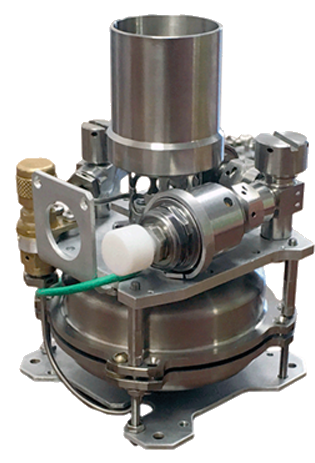
GREEN MONOPROPELLANT PROPULSION SYSTEMS
GREEN MONOPROPELLANT
PROPULSION SYSTEMS
SPACECRAFT PROPULSION SYSTEMS

DESCRIPTION
BASIC SPECIFICATIONS
| Working medium – HAN based | |
| Pressurant – isobutane | |
| Total thrust impulse, kN·s | 0.32 |
| Total thrust impulse in one work cycle, N·s | not less than 1.0 |
| Monopropellant mass, kg | 0.15 |
| Total power consumption for single actuation, W·h | not more than 13.0 |
| Thrust, N | 0.153 |
| Active existence period, year | not less than 1.0 |
| Mass, kg | 1.1 max |
| Overall dimensions, mm | 100х100х135 |
TESTS
ABLATION JET ENGINE
ABLATION JET ENGINE
SPACECRAFT PROPULSION SYSTEMS
DESCRIPTION
BASIC SPECIFICATIONS
| Working medium | fluoroplastic |
| Thrust, mN | 0.1 |
| Specific impulse, m/s | 20 000 |
| Total impulse, N·s | 200 |
| Maximum power consumption, W | 20 |
| Dimensions of engine, mm | 90х21х32 |
| Dimensions of power and control unit, mm | 100х100х30 |
ADVANTAGES
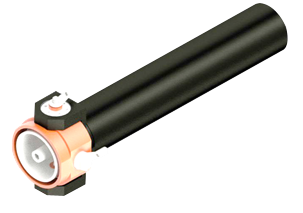
ABLATION JET ENGINE
ABLATION JET ENGINE
SPACECRAFT PROPULSION SYSTEMS

DESCRIPTION
BASIC SPECIFICATIONS
| Working medium | fluoroplastic |
| Thrust, mN | 0.1 |
| Specific impulse, m/s | 20 000 |
| Total impulse, N·s | 200 |
| Maximum power consumption, W | 20 |
| Dimensions of engine, mm | 90х21х32 |
| Dimensions of power and control unit, mm | 100х100х30 |
ADVANTAGES
AMMONIA JET PROPULSION SYSTEMS
AMMONIA JET PROPULSION SYSTEMS
AMMONIA PROPULSION SYSTEM FOR MicroSat-M SC
AMMONIA PROPULSION SYSTEM
FOR MicroSat-M SC
AMMONIA JET PROPULSION SYSTEMS
DESCRIPTION
The ammonia propulsion system (APS) is designed for correction of SC injection error in orbital period and orbital period keeping during active lifetime.
BASIC SPECIFICATIONS
| Total thrust pulse, N·s (kgf·s): | |
| – in hot mode | 7000 (714) |
| – in cold mode | 2500 (255) |
| One engine thrust in hot and cold modes, N (gf) | 0.049 (5) |
| Thrust deviation from nominal value, %: | |
| – in hot mode | ±15 |
| – in cold mode | ±22 |
| Number of APS firings during ALT | up to 500 |
| Number of engines, pcs | 2 |
| Duration of one firing, min | 15, no more |
| – in hot mode | 2500 (255) |
| – in cold mode | 882 (90) |
| Direct-current power voltage, V | 24 to 34 |
| Maximum power consumption of APS at nominal power voltage of 28 V, W | 375 |
| APS mass (dry), kg | 24 |
TESTS
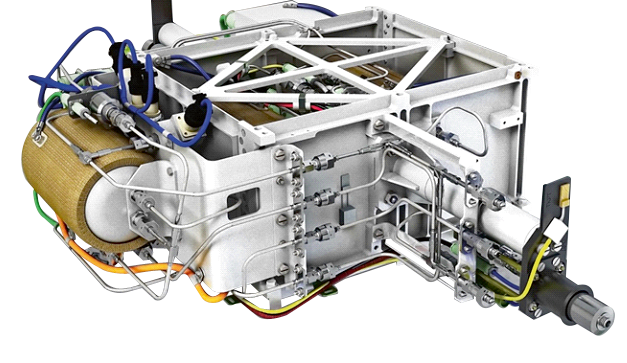
AMMONIA PROPULSION SYSTEM FOR MicroSat-M SC
AMMONIA PROPULSION SYSTEM
FOR MicroSat-M SC
AMMONIA JET PROPULSION SYSTEMS

DESCRIPTION
The ammonia propulsion system (APS) is designed for correction of SC injection error in orbital period and orbital period keeping during active lifetime.
BASIC SPECIFICATIONS
| Total thrust pulse, N·s (kgf·s): | |
| – in hot mode | 7000 (714) |
| – in cold mode | 2500 (255) |
| One engine thrust in hot and cold modes, N (gf) | 0.049 (5) |
| Thrust deviation from nominal value, %: | |
| – in hot mode | ±15 |
| – in cold mode | ±22 |
| Number of APS firings during ALT | up to 500 |
| Number of engines, pcs | 2 |
| Duration of one firing, min | 15, no more |
| – in hot mode | 2500 (255) |
| – in cold mode | 882 (90) |
| Direct-current power voltage, V | 24 to 34 |
| Maximum power consumption of APS at nominal power voltage of 28 V, W | 375 |
| APS mass (dry), kg | 24 |